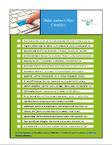
Are you making your insureds feel small?
The difference often comes down to how the claimant is serviced when they need you most!
Today’s insurance market can be defined as the perfect storm! Carriers want to lower cost, claimants want their money faster and digital payment methods are plentiful! Now is the time to stop blowing in the wind with paper checks!
As carriers embrace ways to streamline claims processing and meet policyholders expectations, there is a sense of competitive urgency to move beyond paper checks. According to the latest Association for Financial Professionals (AFP) Payments Guide, the average cost to issue a paper check is $7.00 - $8.00 per check. And, the average time to print, mail and deliver a check is about five to seven days.
These numbers are staggeringly high when compared to the immediacy of low cost ways to issue payments electronically. The Aite Group calculates the U.S. economy could save an average of $3.3 billion in B2C check issuance costs by converting to electronic disbursements.
Therefore, Carriers are looking for ways to implement digital disbursement capabilities with the least amount of IT expenditure, security risk and maintenance effort while increasing the positive impact to their customer service, net promoter scores and ROI.
It is important to remember that a claimant’s experience with their claims handling is no longer confined like the sound of tree falling in the forest. Rather, claimants are embracing social media to share and broadcast their good and bad experiences so the world can get full exposure of how well carriers are treating their policy holders. The single most important time your company’s brand will come to life is when your insureds have a claim. Your claimants will decide whether the emotional trust and investment they’ve made in your company was a good decision or not. And, they will eagerly share their feelings with the world via social media. Are you ready?
There are better ways to handle claims!
One example of the more modern approach to claims handling is touch-less claim processing. In this workflow, carriers allow claimants to initiate and self-manage the claims process from FNOL to closure. Of course, the culmination of meeting claimants’ expectations requires their claim payment to be delivered quickly. If not, all that goodwill and sense of instant satisfaction screeches to halt if the claimant is required to wait for a paper check to be physically approved, printed and mailed!
Instant gratification, not just at the time of crisis, but even in day-to-day claims has become a significant competitive advantage. If you are reading this, you probably already understand that the marketplace is demanding that carriers need to be easy-to-do business with, at all times. Claimants expect the same level of service they get from other industries, like shopping on Amazon. They do not want to hear excuses regarding any delay of their claim and payment.
Instead, claimants expect that the carriers know the formula for most claims. Using appraisal tools, cost analysis and their algorithms, carriers should be able to process and close the majority of claims like ordering a meal off a fast-food menu. Hence, it should take a small fraction of time to process a claim instead of waiting weeks. And, when it’s time for the claim payment, claimants want options. As easy as carriers have made it to pay their premiums, claimants want carriers to offer quick and easy ways to be paid themselves. The goal is to get usable funds fast, if not immediately.
From Moneygram and Western Union for those without bank accounts, to Zelle, Venmo, Square Cash and PayPal that prefer to simply use their email addresses or cell phone numbers as their proxy identity to their accounts, payees want ease of transaction and access to their money.
MasterCard and Visa now offer push payments to debit cards. The same along with AMEX and Discover allow push payments to payees credit cards. Even the trusty old check has gone electronic with Deluxe’s eCheck that allows carriers to send an email notification to the payee to let them retrieve and print the check local to themselves, similar to printing our own boarding passes or concert tickets today.
Now the big question for carriers are:
- What payment methods should be offered to payees?
- With so many core systems capable of issuing payments, how can the carrier apply these payment methods easily across their enterprise?
- How can the payment methods be presented to the payees for their self-selection and processing?
- How can payments issued via these new methodologies be reconciled?
Savvy carriers know the answer is PayPilot(R) Disbursement Hub.
PayPilot makes it easy to apply new, additional payment methods to carriers' core systems, for claim payments, premium refunds, commissions, vendor payments, and more.
With PayPilot, carriers do not have to integrate each of their core systems with each payment method option anymore. PayPilot is perpetually vetting and offering additional payment method options as a superset for carriers to consider and offer.
To learn how you can provide better service to your customers by providing additional payment method capabilities, we welcome your call or email.



